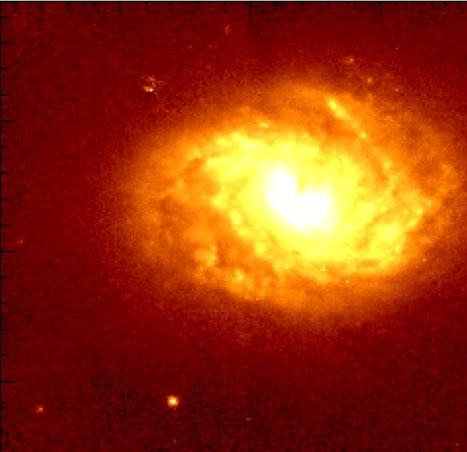Nov 9 2020
A galactic bar is the roughly linear structure of stars and gas extending along the inner regions of certain galaxies. The bar extends from one inner spiral arm to an arm on the other side over the nuclear region.
 A near-infrared Hubble image of the luminous, barred spiral galaxy ESO320-G030. Infrared observations and modeling of over a dozen molecular species at its center reveal massive inflows of gas to a nuclear region undergoing a burst of star formation and dominated by three-components, a small warm core, a disk, and an outer envelope. Image Credit: NASA/HST; Alonso-Herrero et al.
A near-infrared Hubble image of the luminous, barred spiral galaxy ESO320-G030. Infrared observations and modeling of over a dozen molecular species at its center reveal massive inflows of gas to a nuclear region undergoing a burst of star formation and dominated by three-components, a small warm core, a disk, and an outer envelope. Image Credit: NASA/HST; Alonso-Herrero et al.
Galactic bars occur in almost half of the spiral galaxies, such as the Milky Way, and are considered to funnel enormous amounts of gas into the nuclear regions. This has intense impacts on the region that has bursts of star formation and the quick expansion of the supermassive black hole at the center.
For instance, quasars have been regarded as one such consequence of activity of this type. However, ultimately, feedback from such energetic events (for instance, supernovae) stops the inflow and delays the expansion of the black hole.
Insights into how gas inflows and bars form and evolve are very poor—galaxy mergers are considered to be behind these phenomena—and the physical properties of galactic nuclei that still actively accumulate gas are also not understood so well.
A major challenge is that dust in the dense material that surrounds the nucleus does not allow optical radiation to pass through it and, based partially on the geometry, can obscure observations. Infrared and submillimeter wavelength measurements with the ability to peer through the dust are the best means to overcome this challenge.
ESO 320-G030, a luminous, barred galaxy, is located about 150,000 light-years away without any signs of having been in a merger. However, this galaxy features a bar with a length of almost 60,000 light-years. It also includes another bar about 10 times smaller and perpendicular to the first one.
Although this galaxy exhibits high star formation activity in the nuclear region, it has no obvious evidence of an active nucleus, maybe due to the high extinction. Moreover, the galaxy is observed with inflowing gas (and proof of outflows at the same time), which makes it a nearby prototype of isolated, fast-evolving galaxies powered by their bars.
Astronomers Eduardo Gonzalez-Alfonso, Matt Ashby, and Howard Smith from CfA headed a program that involved far-infrared Herschel spectroscopy of this object, together with ALMA submillimeter observations of the gas.
They carefully modeled the shapes of the infrared absorption lines of water and many of its isotopic and ionized variations, including 15 other molecular species such as NH, OH, and ammonia. Their conclusion was that a nuclear starburst of approximately 20 solar-masses of stars each year is being sustained by gas inflow with a short lifetime of 20 million years.
They have found proof for three structural components—a dense circumnuclear disk with a radius of about 120 light-years, an envelope measuring nearly 500 light-years across, and a compact core or torus with a size of 40 light-years and featuring very warm dust. Together, these three components account for almost 70% of the luminosity of the galaxy.
ESO 320-G030 is a remarkable example, as it is bright and located closeby, but the findings indicate that similar complex nuclear structures, with inflows and outflows, may be found commonly in luminous galaxies that exist in the more distant universe, such as those during its most active epoch of star formation.
Journal Reference:
González-Alfonso, E., et al. (2020) A proto-pseudobulge in ESO 320-G030 fed by a massive molecular inflow driven by a nuclear bar. Astronomy & Astrophysics. doi.org/10.1051/0004-6361/202039047.
Source: https://www.cfa.harvard.edu/sao